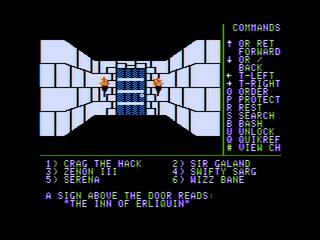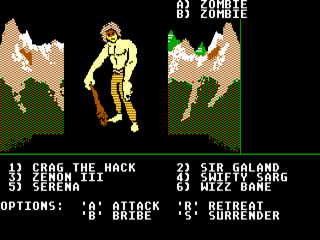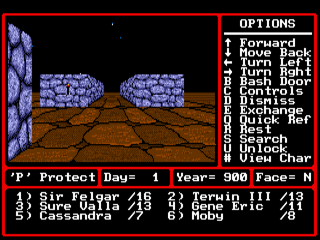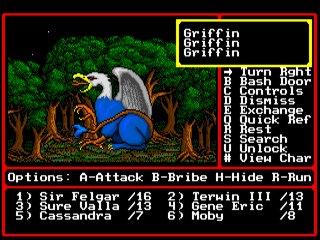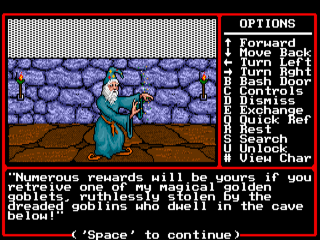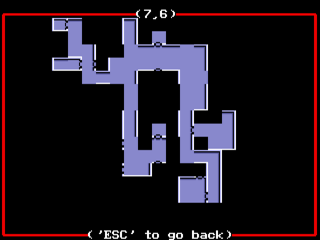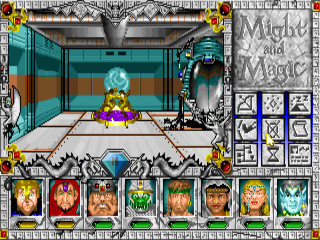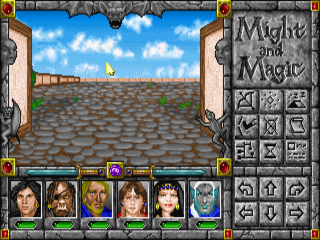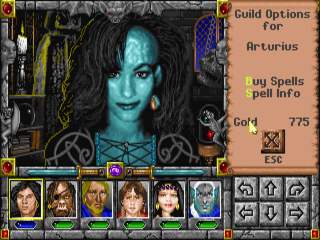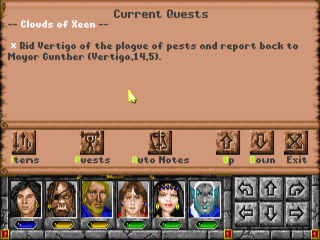Wizardry and Ultima were great inspirations for me. But I wanted to make my own vision for a CRPG. I wanted more of an open-world feel, with quests, puzzles, and an emphasis on exploration and discovery. I wanted party-based tactical combat, tons of magic items to find, and an ever-increasing feeling of power as you leveled your characters. Most of all, I wanted players to feel free to experiment with all of the “tools” I put in the game, so that they could enjoy playing any way they wanted to.
— Jon Van Caneghem
The long-running Might and Magic CRPG series is an easy thing for a project like this one to overlook. These games were never obviously, forthrightly innovative, being content to rework the same high-fantasy territory over and over again. Meanwhile their level of commercial success, although certainly considerable at times, never became so enormous as to make them sit up and demand our attention.
What Might and Magic consistently did have going for it, however, was the quality of being fun. Jon Van Caneghem, the series’s guiding light, was himself a lifelong compulsive gamer, and he stuffed his creations full of the things that he himself enjoyed: quests to fulfill, dungeons to explore, loot to collect, and an absurd variety of monsters to fight, all couched inside a non-linear, open-ended philosophy of gameplay that eschewed the sort of (overly?) elaborate set-piece plots that had begun to mark many of his series’s peers by the dawn of the 1990s. Might and Magic games, in other words, weren’t so much stories to be experienced as places to be explored.
Chet Bolingbroke — better known as The CRPG Addict — names “generous” as his defining adjective for Might and Magic.
The Might and Magic games have always been generous. Jon Van Caneghem clearly had a history with tabletop RPGs and early CRPGs, but he envisioned worlds of bounty where those titles were sparse and unyielding. In Wizardry, Might and Magic’s most obvious forebear, a 16 x 16 map might only hold a couple of fixed combats and two textual encounters. Van Caneghem’s strategy was to give you something in every row and column. I have maps from the first game in which I had to go into the double letters to annotate everything. A Dungeons & Dragons module might take you from Level 2 to 5 over the course of 30 hours of campaigning. Van Caneghem had no problem offering games in which you hit Level 100 or more. Where Dungeons and Dragons and Wizardry regarded attributes as closely policed within a 3-18 range, you might start at 15 strength in Might and Magic and end at 500.
Throughout its long history as a series, Might and Magic never strayed far from this gonzo approach. It remained always that which it had first aspired to be: an exercise in exploring spaces, killing the monsters you met there, and taking their stuff so that you could use it to kill even tougher monsters somewhere else. But within that template, it did find room to innovate — to do so, in fact, in more ways than it’s generally given credit for, including a few innovations that have become staples of the CRPG genre today. If it was no poster child for games as art, it had arguments of its own to make for games as pure fun.
Jon Van Caneghem was in some ways the last of a breed: the last of the living-room gaming entrepreneurs who dominated at the very start of the industry, with their self-coded products, their homemade packaging, and their naïve gumption that took the place of business plans and venture capital.
Van Caneghem grew up as a child of privilege in the 1970s near the heart of Hollywood, the stepson of a prominent neurologist. His parents had high ambitions for him; he attended grade school at the elite bilingual Lycée Français de Los Angeles. But he never quite fit the mold his parents had cast for him. A slow reader and reluctant student, he was obsessed with games from a very young age, beginning with checkers, then moving on to chess, Risk, and Diplomacy, then to Avalon Hill’s wargames and finally, inevitably to Dungeons & Dragons. He entered UCLA as a pre-med student in 1979, but becoming a doctor was his parents’ dream for him, not his own. Once there, he continued to devote the bulk of his energies to playing games, as well as another, more dangerous obsession: racing cars on the legendary Mulholland Drive.
Van Caneghem discovered computers and computer games during his middle years at university, just as many of his friends were finding jobs and significant others, and were left with less time for game nights as a result. “Then a friend of mine showed me an Apple II, and he was playing a bunch of simple games on it,” he remembers. “This was great! I could play any time I wanted and didn’t have to wait for anyone to get together. So, I immediately got one.”
Like at least half of the Apple II world at the time, he was soon in the throes of a full-blown Wizardry addiction; he guesses he must have finished it “seven or eight times.” The original Ultima also consumed plenty of hours. It was ironically the flaws in these pioneering but technologically limited early CRPGs that drove him to go from being a game player to a game maker.
Everyone started to tell me, “You’re always complaining about these games. Why don’t you make your own?” And I said that I didn’t have the slightest idea how to program. But it intrigued me. I switched from being a pre-med student to a math and computer-science major at UCLA and just started delving into the Apple II, absorbing every magazine and piece of information I could find. Everything I was learning at school was just ancient history as far as the computer was concerned, with punched cards and mainframes. There was nothing about personal computers. So I pretty much had to teach myself everything.
Much to his parents’ relief, he finished his Bachelor’s program at UCLA in 1983, albeit not in the major they had planned for him. Then he dropped a bombshell on them: he wanted to make his own computer game and sell it. They reluctantly agreed to give him a couple more years of room and board while he chased his dream.
In the end, it would take him almost three years to make the grandiosely titled Might and Magic: Book One — The Secret of the Inner Sanctum. In what Van Caneghem still calls the most satisfying single creative experience of his life, he designed and programmed the whole thing himself. He drew the graphics with some help from a pair of outside artists he hired, and outsourced some of the writing to his wife. But at least 90 percent of the sprawling final product was his work alone.
When he began to shop the game around to publishers at last in 1986, he found they were very interested; CRPGs were enjoying a boom at that time, with Ultima IV and The Bard’s Tale having been two of the biggest hits of the previous year. Yet he was sadly underwhelmed by the terms he was offered, which might allow him to earn $1 per copy sold at a retail price of $35 or more.
So, having come this far alone, he decided to self-publish his game. Being a self-described “ultimate Star Trek nut,” he chose New World Computing — as in “strange new worlds and new civilizations” — for the name of his new company. He recruited friends to draw the art for a box and a rather handsome map of his game’s land of Varn, then bought himself a PO Box and a toll-free order line along with advertisements in Computer Gaming World and A+, respectively computing gaming’s journal of record and one of the most popular of the Apple II magazines. Having been taught from a young age that success in life often hinges on looking like a success, he pulled out all the stops for the advertisements. Instead of the quarter-page black-and-white ad with fuzzy stick-figure art that was typical of home-grown software entrepreneurs like him, he convinced his parents to splash out one more time for a professionally laid-out, full-page, full-color spread that looked as good as any of those from the more established competition and better than most of them; this was an advertisement that couldn’t help but get Might and Magic noticed.
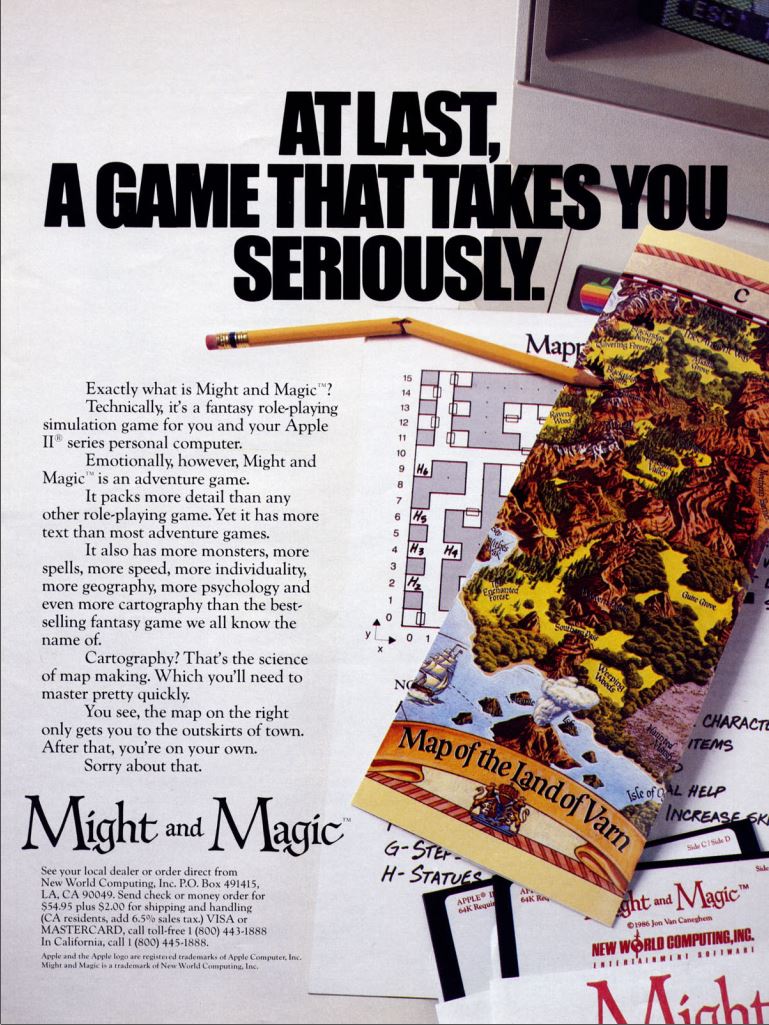
The first Might and Magic advertisement, which came complete with veiled jabs at The Bard’s Tale. It’s amusing to see how it describes pencil-and-paper map-making as a virtue rather than a necessary evil. Most gamers apparently didn’t agree: the very next game in the series would feature one of the CRPG genre’s first simple auto-maps.
And it did get noticed: it was a case of the right game at the right time putting its best foot forward, and the response exceeded all of his expectations. The order line which he’d installed in his bedroom rang all night long, and Van Caneghem, who had no intention of missing a single sale, turned into a sleep-deprived zombie thanks to it. Relief came in the form of another phone call, this one from Jim Levy, the CEO of Activision. Levy explained that Activision was starting something they called an “affiliated-label program” to help small developers get their products to market, and he thought that New World Computing would be an excellent candidate. (He may have been motivated to atone, to Activision’s stockholders if no one else, for his infamous rejection of Interplay’s The Bard’s Tale as “niche-ware for nerds” — a rejection which had delivered to Activision’s arch-rival Electronic Arts their biggest hit to date.) Activision could take phone orders and, much more importantly, distribute Might and Magic to stores all over the country, all while taking a smaller cut than a traditional publisher and leaving the New World logo as the only prominent one on the box; they could even put Van Caneghem in touch with people who could port it to other platforms. It sounded very good indeed to the young entrepreneur.
Within weeks of this conversation, Levy was fired from Activision, but the deal he had made with Van Caneghem remained in place. Might and Magic‘s arrival in stores in early 1987 was heralded by a glowing review in Computer Gaming World from Scorpia, the magazine’s longstanding adventure and CRPG columnist. She called it “world touring on a grand scale”: “There is so much to learn and enjoy in Might and Magic because its scope and complexity are amazing.” Ports to the IBM PC and Commodore 64 were available well before the Christmas of 1987. While it would never quite manage to join Ultima, The Bard’s Tale, and, soon, Pool of Radiance and the other SSI Gold Box games in the very top commercial tier of late-1980s CRPGs, it did become the leading name among the second tier, more than enough to get New World off the ground properly and create high expectations for a sequel.
Despite Scorpia’s rapture over it, this first Might & Magic game was, like all of the ones that would follow it, disarmingly easy to underestimate. It wore the influence of Wizardry and its successors, The Bard’s Tale among them, prominently on its sleeve: it too was an exercise in turn-based, grid-based exploration, which you navigated from a first-person point of view despite controlling a party of up to six characters. (The oddity of this has led to its sub-genre’s modern nickname of “blobber,” for the way it “blobs” all of your characters together into one octopus-like mass of sword-wielding arms and spell-casting hands.) Its technology verged on the primitive even in 1987, the year which saw the introduction of real-time gameplay to the CRPG genre in Dungeon Master. Nor was it any paradigm of balanced design: the early stages, when your newly created party consisted of naked, penniless club-wielders, proved so difficult that Van Caneghem grudgingly added a slightly — slightly, mind you — more hardy pre-made starting party to later releases. Even once your characters made it to level three or so and were no longer as weak as infants, the difficulty level remained more jagged than curved; monsters could suddenly appear on some levels that were an order of magnitude more powerful than anything else you’d met there, killing you before you knew what had hit you. This was an especial problem given that you could only save your game from one of the nine adventurer’s inns scattered around the sprawling world, a result more of technical limitations than designer intent. Meanwhile the story was mostly nonexistent, and silly where it did exist, culminating in the revelation that the entire world of Varn you’d been exploring was really a giant artificial biosphere created by space aliens; “Varn” turned out to be an acronym for “Vehicular Astropod Research Nacelle.”
If you could get past all that, however, it was a surprisingly rich game. Caneghem has noted that, though he became a pretty good programmer in the course of making Might and Magic, he was always a game designer first, a game programmer second: “I wasn’t a programmer who knew a neat graphics routine and then turned it into a game. I think most people at the time, except for a few, came from that end of it.” As one of the few who didn’t, Van Caneghem took a more holistic approach. Here we have to return to this idea of generosity that the CRPG Addict broached for us at the beginning of this article. Primitive though it was, Might and Magic was still crammed to bursting with stuff, enough to fill a couple of hundred hours if you let it: 250 different items to collect, 94 different spells to cast, 200 different monsters to fight, 55 individual 16-square-by-16-square areas to map. It boasted not only dungeons and towns, but a whole grid-based outside world to explore. The lumpy amalgamation was riddled with cheap exploits as well, of course, but discovering them was half the fun. One should never dismiss the appeal of building a group of adventurers from a bunch of babes in the woods who fall over dead if a goblin looks at them sideways to a six-person blob of terror that can annihilate a thousand of the little buggers at the stroke of a key.
For all its manifest derivativeness in the broad strokes, Might and Magic wasn’t without a smattering of genuinely new ideas, at least one of which became quietly influential on the future course of its genre. As you explored its maps, you often met people who gave you quests: tasks to accomplish apart from revealing more territory and collecting more experience points. These could range from such practical affairs as delivering a letter to another town to more, shall we say, whimsical endeavors, such as climbing every tree in a given area. Completing these side-quests provided rewards in the form of additional experience points and riches. More importantly, it added an additional impetus to your wanderings, a new dimension of play that was different from methodically lawn-mowering through a sometimes numbing procession of dungeons and monsters. In time, sub-quests like these would become an essential component of many or most CRPGs.
Jon Van Caneghem took advantage of his first game’s success to set up a proper office for New World in Van Nuys, California, and hire a staff made up of people much like himself. “A lot of our employees had met at game conventions, and all of our roots were in gaming,” he says. “At 5:30, the office would shut down and the gaming would start. Everyone was always there until all hours of the night, playing games.” He noted in a contemporary magazine profile that he wished above all to keep the New World offices “loose, friendly, and creative.”
He and his fellow travelers shipped Might and Magic II: Gates to Another World in December of 1988. Although clearly of the same technological lineage as its predecessor, it was a big step forward in terms of the details. Not only did it offer an even vaster profusion of stuff, spread over 60 different discrete areas this time, but it came with some significant quality-of-life improvements, including a reasonably usable auto-map if you chose to invest in the Cartography skill for at least one of your characters. Another subtle but welcome improvement came in your ability to set a “disposition” for your party, from “inconspicuous” to “thrill-seeker”; this allowed you to set the frequency of random monster encounters to your own liking, depending on whether you were just trying to get someplace or were actively grinding for experience points. But the most obvious improvement of all was the revamped graphics, courtesy of the full-time artists Van Caneghem had now hired; a version for the Commodore Amiga, the audiovisual wundermachine of the era, looked particularly good. The story was as daft as the last one, taking place on another world… err, alien biosphere called Cron instead of Varn. (The stories of Might and Magic do rather tend to satirize themselves…) But, just like last time, it really didn’t matter at all in a game that was all about the joy of exploration and exploitation.
The improved audiovisuals of Might and Magic II highlighted another aspect of the series that had perhaps been obscured by the primitiveness of the first game. In keeping with Van Caneghem’s sunny, optimistic personality — writer and designer Neal Halford, who came to work with him at New World during this era, calls him “terminally mellow” — the environs of Might and Magic would always be bright, colorful, fun places to inhabit. The series would never embrace the “dark, gritty” aesthetics that so much of the games industry came to revel in as the 1990s wore on.
Jon Van Caneghem the businessman seemed to live a charmed life not out of keeping with his vaguely fairy-taleish visual aesthetic. For instance, he dropped Activision in favor of becoming an affiliated label of Brøderbund in 1989, just before the former company — by this point officially known as Mediagenic — imploded, defaulting on their payments to their entire network of affiliated labels and destroying many of them thereby. He even escaped relatively unscathed from a well-intentioned but financially ill-advised venture into the board-game market, which I’ll cover in more detail in my next article.
For now, though, suffice to say that it was a big part of the reason that Might and Magic III: Isles of Terra wasn’t released until 1991. Like its predecessors, this latest entry in the series tossed you into another new world and let you have it. Still, while philosophically and even formally identical to the first two games — it remained a turn-based, grid-based blobber — it was a dramatic leap forward in terms of interface and presentation. Designed on and for a 32-bit MS-DOS machine instead of the 8-bit Apple II, it sported 256-color VGA graphics that replaced many of the older games’ numbers with visual cues, a lovely soundtrack composed for the new generation of multi-voice sound cards, and a mouse-driven interface. But its most gratifying improvement of all was more basic: it finally let you save your progress inside dungeons or anywhere else you liked. I would venture to guess that this change alone cut the number of hours the average player could expect to spend finishing the game in half, in spite of the fact that its number of individual areas actually grew slightly, to 64.
Veterans of the series could and sometimes did complain that the new level of professionalism and polish came at the cost of some of its old ramshackle charm, and Van Caneghem himself has confessed to being worried that people would notice how the new game’s average completion time was more likely to be in the tens than the hundreds of hours. But he needn’t have been: gamers ate it up.
In his review for Computer Gaming World, Charles Ardai captured how impressive Might and Magic III was in many ways, but also made note of the ennui that can come to cling to a series like this one — a series which is dedicated to doing the same thing better in each installment rather than doing anything dramatically, holistically new.
Unfortunately, Might and Magic III is also a remarkable exercise in water-treading, which does not advance the genre one inch in terms of plot, event, or ontology. Here we are again, one realizes, a band of hardy adventurers — elves, gnomes, dwarves, clerics, paladins, sorcerers — tramping about the wilderness and facing off against assorted orcs, rats, bugs, and other stock uglies.
Here we are, once more mapping a corner of Middle-earth, or a reasonable facsimile thereof, in pursuit of yet another necromatic ne’er-do-well with a faux-mythic name and a bad disposition. Here we are again — will we never be somewhere else?
On the other hand, there is a market for this stuff. David Eddings rewrites the same high-fantasy novel over and over again and never fails to hit the bestseller lists with it…
Ardai concluded that “the gamer who wants to be surprised by discovery, conversation, and story is likely to be disappointed in Might and Magic III, while the gamer who simply wants to play [emphasis original] may be ecstatic with the game.” Few sentences sum up the Might and Magic series as a whole more cogently.
The next pair of games in the series pushed the boundaries in terms of size without even attempting to address Ardai’s complaints. (After all, if it worked for David Eddings…) The name of 1992’s Might and Magic: Clouds of Xeen reflected a sudden games-industry conventional wisdom that numbered titles could actually be a drag on sales, being a turn-off to the many folks who were acquiring home computers for the first time in the early 1990s. “I felt strongly that everyone wants to see the next James Bond movie, but no one wants to see Rocky IX,” says Van Caneghem. “So off came the numbers.” This sentiment would die away as quickly as it had flared, both inside and outside of New World.
Both Clouds of Xeen and the would-be Might and Magic V, which was known simply as Might and Magic: Darkside of Xeen upon its release in 1993, took place, as you might have guessed, in yet another new land of adventure known as Xeen. More interestingly, when combined they represented another of New World’s subtle experiments with the nuts and bolts of the CRPG form if not the substance. If you installed them both on the same computer, they turned into World of Xeen, a single contiguous game encompassing no less than 201 discrete areas. Outside of its central gimmick, World of Xeen continued the Might and Magic tradition of careful, compartmentalized evolution. It was, for example, the first CRPG I know of that included an automatic quest log as a replacement for the dog-eared, hand-written notebooks of yore. It also added a global difficulty setting. Van Caneghem:
I added a feature when you first start the game where you’re asked if you want an Adventurer game or a Warrior game. This was my wife’s idea. She really liked the game, the adventure. But she wasn’t into combat. She was like, well, you know, monsters are fun, but let’s get on with the story. I said, “Okay, well, I’m sure there’s plenty of people out there just like you, who aren’t into the numbers and the hit points. They just want to get on with the story.” There’s a lot of quests, a lot of fun things to do. So I put the choice in, and what Adventurer does is it makes it easier to win all the battles. So you get through that part of the game a lot quicker.
There’s other stuff to do, and we want to expand our audience, to bring in more and more people who wouldn’t normally play this kind of game.
But this notion of “expanding our audience” was becoming a sticking point for Might and Magic by the time the conjoined World of Xeen appeared in the inevitable single box in 1994. Some of Charles Ardai’s criticisms appeared to be coming home to roost; the market had been flooded with fantasy CRPGs over the last half decade, most of which appeared all but indistinguishable from one another to the casual browser. It was extremely difficult even for a well-done example of the form, such as Might and Magic had always been on the whole, to stand out from the competition. The new generation of gaming neophytes to whom Van Caneghem imagined his Adventurer mode appealing didn’t have the likes of Might and Magic and its peers on their radar at all; they were buying things like The 7th Guest, Myst, and Phantasmagoria. The CRPG genre had transitioned from boom to bust, and was now deeply out of fashion.
This reality left Jon Van Caneghem and his company facing some hard questions. The engine which had powered the last three Might and Magic games was several years old now, its once-impressive VGA graphics looking a bit sad in comparison to the latest high-resolution Super VGA wonders. Clearly it would need to be rethought and rebuilt from scratch for any possible Might and Magic VI. But was there really a business case for taking on such an expensive task in the current market? Or had the franchise perhaps run its course, as such venerable rivals as Wizardry, The Bard’s Tale, and Ultima seemed to have done?
Van Caneghem’s solution to this dilemma of what was to be done with a respected CRPG franchise in an era when CRPGs themselves seemed to be dead on the vine would prove as unexpected as it would refreshing, and would spawn a great rarity in gaming: a spinoff franchise that became even more popular than its parent.
(Sources: the book Might and Magic Compendium: The Authorized Strategy Guide by Caroline Spector and the individual hint books published by New World Computing for each of the first five Might and Magic games; Compute! of May 1993; Computer Gaming World of December 1986, April 1987, October 1988, March 1989, May 1989, May 1991, January 1992, September 1993, and April 2004; Retro Gamer 49; XRDS: The ACM Magazine for Students of Summer 2017. Online sources include the CRPG Addict’s final post on Might and Magic: Darkside of Xeen, Matt Barton’s interviews with Jon Van Caneghem and Neal Hallford, and the RPG Codex interview with Jon Van Caneghem.
The first six Might and Magic CRPGs can be purchased as a digital bundle at GOG.com.)
